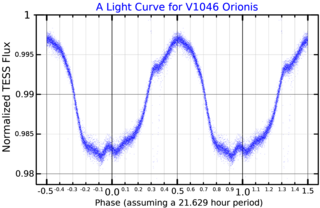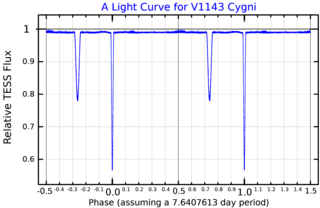Related Research Articles

Lambda Andromedae, Latinized from λ Andromedae, is the Bayer designation for a binary star system in the northern constellation of Andromeda. At an estimated distance of approximately 84.6 light-years from Earth, it has an apparent visual magnitude of +3.8. This is bright enough to be seen with the naked eye. The system is drifting further away from the Sun with a radial velocity of +6.8 km/s.

Phi Aquilae, Latinized from φ Aquilae, is the Bayer designation of a binary star system in the equatorial constellation of Aquila. It has an apparent visual magnitude of +5.28 and is visible to the naked eye. With an annual parallax shift of 14.198 mas, this star is located at a distance of approximately 230 light-years from Earth. It is drifting closer with a radial velocity of –27 km/s. Based on its motion through space, this system is considered a possible member of the nearby Argus association of co-moving stars, although it may be too old.

8 Andromedae, abbreviated 8 And, is a probable triple star system in the northern constellation of Andromeda. 8 Andromedae is the Flamsteed designation. It is visible to the naked eye with an apparent visual magnitude of 4.82. Based upon an annual parallax shift of 5.7 mas, it is located about 570 light years from the Earth. It is moving closer with a heliocentric radial velocity of −8 km/s.
41 Andromedae is a single star in the northern constellation of Andromeda. 41 Andromedae is the Flamsteed designation. It is bright enough to be faintly visible to the naked eye, having an apparent visual magnitude of 5.04. Based upon an annual parallax shift of 16.4 mas, it is located 198 light years away. The star is moving further from the Earth with a heliocentric radial velocity of +10 km/s and it has a relatively high rate of proper motion, traversing the celestial sphere at the rate of 0.171″ per year.

28 Andromedae is a Delta Scuti variable star in the constellation Andromeda. 28 Andromedae is the Flamsteed designation. It also bears the variable star name GN Andromedae. Its apparent magnitude is 5.214, varying by less than 0.1 magnitudes.
23 Andromedae, abbreviated 23 And, is a presumed single star in the constellation Andromeda, although it has been a suspected spectroscopic binary. 23 Andromedae is the Flamsteed designation. Its apparent visual magnitude is 5.71, which indicates it is dimly visible to the naked eye under good viewing conditions. The distance to 23 And, as determined from its annual parallax shift of 26.8 mas, is 121.6 light years. The star is moving further from the Earth with a heliocentric radial velocity of −27 km/s. It has a relatively high proper motion, traversing the celestial sphere at the rate of 0.191″ per year.
6 Andromedae is an astrometric binary star system in the northern constellation of Andromeda. The designation comes from the star catalogue of John Flamsteed, first published in 1712. Its apparent visual magnitude is 5.91, which is just bright enough to be visible to the naked eye under good seeing conditions. Based upon an annual parallax shift of 34.1 mas as seen from Earth, it is around 96 light years from the Sun. It is moving closer to the Sun with a radial velocity of −32.4 km/s. The system has a relatively high proper motion, advancing across the celestial sphere at the rate of 0.272 arc seconds per annum.

15 Cancri is an α2 CVn-type variable star in the zodiac constellation of Cancer, located around 980 light years away. It has the variable star designation BM Cancri ; 15 Cancri is the Flamsteed designation. This system is visible to the naked eye as a faint, white-hued star with an apparent visual magnitude of about 5.6. It is moving away from the Earth with a heliocentric radial velocity of 25 km/s.
HD 142 is a wide binary star system in the southern constellation of Phoenix. The main component has a yellow-white hue and is dimly visible to the naked eye with an apparent visual magnitude of 5.7. The system is located at a distance of 85.5 light years from the Sun based on parallax measurements, and is drifting further away with a radial velocity of +6 km/s.

Phi Piscium, Latinized from φ Piscium, is a quadruple star system approximately 380 light years away in the constellation Pisces. It consists of Phi Piscium A, with a spectral type of K0III, and Phi Piscium B. Phi Piscium A possesses a surface temperature of 3,500 to 5,000 kelvins. Some suggest the only visible companion in the Phi Piscium B sub-system is a late F dwarf star, while others suggest it is a K0 star. The invisible component of the Phi Piscium B sub-system is proposed to have a spectral type of M2V. The star system has a period of about 20½ years and has a notably high eccentricity of 0.815.
HD 172044 is a triple star system in the northern constellation of Lyra. It has a blue-white hue and is visible to the naked eye with an apparent visual magnitude of 5.41. The distance to the primary component is approximately 535 light years based on parallax. It is drifting closer with a radial velocity of −32.5 km/s, and is predicted to come as near as 77.3 light-years to the Sun some 4.5 million years from now.
HD 167965 is a single star in the northern constellation of Lyra. It is dimly visible to the naked eye on a sufficiently dark night, having an apparent visual magnitude of 5.56. The star is located at a distance of approximately 590 light years from the Sun based on parallax. It is drifting closer with a radial velocity of −20.5 km/s and is predicted to come as near as 72.7 light-years in around 8.5 million years.

HD 37017 is a binary star system in the equatorial constellation of Orion. It has the variable star designation V1046 Orionis; HD 37017 is the identifier from the Henry Draper Catalogue. The system is a challenge to view with the naked eye, being close to the lower limit of visibility with a combined apparent visual magnitude of 6.55. It is located at a distance of approximately 1,230 light years based on parallax, and is drifting further away with a radial velocity of +32 km/s. The system is part of star cluster NGC 1981.
HD 30453 is a binary star system in the northern constellation of Auriga. It is visible to the naked eye with an apparent visual magnitude of 5.86. The system is located at a distance of approximately 334 light years from the Sun based on parallax. It is drifting further away from the Sun with a radial velocity of 16.65 km/s.

47 Cygni is a triple star system in the northern constellation of Cygnus, and is located around 4,000 light years from the Earth. It is visible to the naked eye with a combined apparent visual magnitude of 4.61. The system is moving closer to the Earth with a heliocentric radial velocity of −4.6 km/s.
38 Geminorum is a binary star system in the northern zodiac constellation of Gemini. It has the Bayer designation e Geminorum, while 38 Geminorum is the Flamsteed designation. This system is visible to the naked eye as a faint, white-hued point of light with an apparent visual magnitude of 4.71. The primary component is a magnitude 4.75 star, while the secondary is magnitude 7.80. The system is located about 98 light years away from the Sun based on parallax, and is drifting further away with a radial velocity of +16 km/s. It is a potential member of the Tucana–Horologium stellar kinematic group.
23 Orionis is a double star located around 1,200 light-years away from the Sun in the equatorial constellation of Orion. It is visible to the naked eye as a dim, blue-white-hued point of light with a combined apparent visual magnitude of 4.99. The pair are moving away from the Earth with a heliocentric radial velocity of +18 km/s, and they are members of the Orion OB1 association, subgroup 1a.

16 Lacertae is a triple star system in the northern constellation of Lacerta, located about 1,580 light years from the Sun. It has the variable star designation EN Lacertae; 16 Lacertae is the Flamsteed designation. This system is visible to the naked eye as a faint blue-white hued star with a maximum apparent visual magnitude of +5.587. It is moving closer to the Earth with a heliocentric radial velocity of –12 km/s.

HR 7484 is a binary star system in the northern constellation of Cygnus. It is dimly visible to the naked eye under good viewing conditions, having an apparent visual magnitude of 5.89. Based upon an annual parallax shift of 24.71, it is located 132 light years away. The system is moving closer with a heliocentric radial velocity of −14 km/s.
HD 112014 is a star system in the northern constellation of Camelopardalis. It is dimly visible as a point of light with an apparent visual magnitude of 5.92. The distance to this system is approximately 415 light years based on parallax measurements.
References
- 1 2 3 4 5 6 Brown, A. G. A.; et al. (Gaia collaboration) (August 2018). "Gaia Data Release 2: Summary of the contents and survey properties". Astronomy & Astrophysics . 616. A1. arXiv: 1804.09365 . Bibcode: 2018A&A...616A...1G . doi: 10.1051/0004-6361/201833051 . Gaia DR2 record for this source at VizieR.
- 1 2 3 4 5 6 7 8 9 10 11 12 13 14 Fekel, Francis C.; et al. (September 2011), "New Precision Orbits of Bright Double-lined Spectroscopic Binaries. VII. 47 Andromedae, 38 Cassiopeiae, and HR 8467", The Astronomical Journal, 142 (3): 13, Bibcode:2011AJ....142...69F, doi: 10.1088/0004-6256/142/3/69 , 69
- 1 2 Cowley, A.; et al. (April 1969), "A study of the bright A stars. I. A catalogue of spectral classifications", Astronomical Journal, 74: 375–406, Bibcode:1969AJ.....74..375C, doi:10.1086/110819.
- ↑ Abt, Helmut A.; Morrell, Nidia I. (1995). "The Relation between Rotational Velocities and Spectral Peculiarities among A-Type Stars". The Astrophysical Journal Supplement Series. 99: 135. Bibcode:1995ApJS...99..135A. doi: 10.1086/192182 .
- 1 2 Gontcharov, G. A. (November 2006), "Pulkovo Compilation of Radial Velocities for 35495 Hipparcos stars in a common system", Astronomy Letters, 32 (11): 759–771, arXiv: 1606.08053 , Bibcode:2006AstL...32..759G, doi:10.1134/S1063773706110065, S2CID 119231169.
- ↑ De Rosa, R. J.; et al. (2014), "The VAST Survey - III. The multiplicity of A-type stars within 75 pc", Monthly Notices of the Royal Astronomical Society, 437 (2): 1216, arXiv: 1311.7141 , Bibcode:2014MNRAS.437.1216D, doi:10.1093/mnras/stt1932, S2CID 88503488.
- ↑ "47 And". SIMBAD . Centre de données astronomiques de Strasbourg . Retrieved 2018-02-22.
- ↑ Plaskett, J. S.; Young, R. K. (February 1919). "Notes from the Dominion Astrophysical Observatory, Victoria, B.C.. Second list of spectroscopic binaries". Journal of the Royal Astronomical Society of Canada. 13: 59–64. Bibcode: 1919JRASC..13...59P .